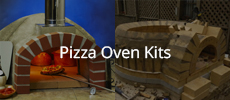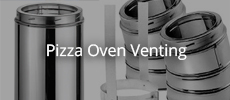Neapolitan dome reinforcement
David kindly brought this to my attention, that because of the accentuated curve of the Neapolitan style oven, it requires additional reinforcement of the lower soldier course. I have a clear idea of what needs to be done, see images posted by David a few posts before this one. See also in the images provided for oven build in Napolitian style 106cm build inside a hobbit house.
This sent me down a rabbit hole. I’ve spent countless hours researching, googling trying to find similar applications of this type of reinforcement to see if I can buy some stainless steel bands. I came across 2 example where it is used. Reinforcing walls of old water tanks, and hot tub hoops. In the US, it might be easier to get hot tub hoops made to order. Here in Germany not, but I did find a hot tub complany in Estonia that would gladly make and send them to me in Germany.
I‘m no expert with steel, but I found out in Germany V2A Stainless steel (also known as 1.4301), or V4A stainless steel (the newer version) is rustproof, heat resistant to 600C, and easily welded using all electrical methods. It is relatively inexpensive too when I contacted a supplier to ask about the price of 2 x V2A stainless steel bands 3000 x 50 x 1.5mm.
I‘m making brackets similar to what is used in the Napolitian style 106cm build inside a hobbit house. I will connect the band to the brackets with solid stainless steel rivets. The Bands will be secured to the front of the oven with M10 bolts anchored to angle at the arch.
I‘m just documenting this in case someone else also needs information about bands and what to use, or where to get it. I‘m going this route as it is by far the most inexpensive, and will give a good result. Hot tub hoops would also work, if your somewhere where you can get them.
Announcement
Collapse
No announcement yet.
2024 Neapolitan oven build
Collapse
X
-
The products you referenced are mortars and are not likely to be suitable. Get a bag of dense castable refractoryy. It contains calcium aluminate cement which is more heat tolerant than ordinary Portland cement OPC, high temperature aggregates and burnout fibres which reduce the risk of explosive steam spalling.
"I’m not sure what temp it gets in the vent," Put it this way, the black soot in my flue gallery never burns off and that happens at around 300C. OPC starts to degrade north of 300C, but to be safe castable refractory would be a safer choice for your flue galleryLast edited by david s; 02-02-2024, 04:35 PM.
- Likes 1
Leave a comment:
-
I was exploring using it to cast a light weight vent between the top of the arch and the flu. See image dotted lines. I just found out I get a 5% rebate for signing up to emails from the supplier I’m getting my materials, so I might just spend half that rebate on 25kg of castable refractory.
I’m not sure what temp it gets in the vent, but far from the temp of the dome. I think it would stand the heat there. The structure of the chimney will be built around it. The harshest treatment it might get will be when it gets cleaned.Last edited by daidensacha; 02-02-2024, 01:57 PM.
Leave a comment:
-
Where are you intending to use this product? Is it as a mortar for the inner brick dome?
Or Is it a cement render for the exterior?
What temperature are you expecting it to withstand in the area you intend to use it?
Leave a comment:
-
Mortar: Waterproof or Vapor permeable water resistant?
I wonder if someone has some knowledge that would help me choose the best option?
My final order is almost ready to be put in, but I’m having a dialog with the supplier who has 2 types of mortar, and is recommending the vapor permeable water resistant one. Here is a breakdown of the two products.
1. Weber.dur 136 oven plaster - light plaster mineral - grain size 0-1mm - 30kg- water-repellent
- water vapour permeable
- offers optimal adaptation to heat-insulating masonry
- water-repellent
- weather and frost resistant
- mechanically highly resilient
- offers optimal adaptation to heat-insulating masonry
The supplier recommends the Weber.dur 136, and says that the water permeability is important to allow any moisture in the oven to escape. I was planning on waterproofing the oven in the end. While it will be under a terrace it will also catch rain and snow in heavier weather conditions. My thought is if water can get out, water can get in. I’m accutely aware of the importance of ensuring the oven remains try during the build, so will keep it covered. Also ensuring adequate drying time between vermicrete coats. I thought that when cooking with the oven at 500C, any moisture from the cooking will vaporise, and be vented though the oven opening and flu vent.
Did I misunderstand something? Is it better to waterproof, or not? Is water permeability more important than water proofing with this style of oven?
Any feedback really appreciated.
UPDATE: Read through thread Waterproofing dome and it seems this topic is well covered. Vapor permeable is the way to go.Last edited by daidensacha; 02-02-2024, 07:33 AM.
Leave a comment:
-
There is a guy on Youtube with a channel only about concrete, he knows hi stuff. So many different playlists, but the one I that drew me to his channel was about vermicrete. You might be interested in his playlist of lightweight aggregates, He makes and tests the strength and weight of vermiculite and perlite at different ratios. Another aggregate he mentioned was pumice. My ears pricked up because I have 10kg of 2-8mm lava pumice I bought for bonsai years ago. I’m going to test a mix of vermiculite and pumice to see if it would be a viable mix for the vent. In the end of the day it might just be worth coughing up 50 bucks and getting a 25kg bag of castable refractory cement.Originally posted by david s View PostAny gap to reduce heat transfer by conduction does little to prevent heat transfer by radiation, but a gap of around 8mm does work to reduce heat transfer significantly.
I cast my flue gallery using castable refractory. But as the flue gallery sees much lower temperatures than the oven dome or floor there are alternatives. I don't think standard concrete is adequate, but using the homebrew as a castable does stand up to the service temperatures we use ok. Creating a mould, then making a casting from it that will release properly is difficult and not really viable for a one off cast. However a hybrid solution is far easier to make using a sand hump mould covered in cling wrap, reduces thermal mass and also allows for a much shallower entry which makes working the oven far easier. The drawing should tell the story. It show a butchered anchor plate set into the wet casting for later attachment of the flue pipe. The second drawing shows how a more funnelled gallery performs better.
On the image above, with the tow different size vent openings. I’ve seen a variety builds but little advice about the vent opening size and what is recommended. On the right it seems overkill, and almost like putting an open window in the oven dome to cool the house down. On the left, I went wide for when the fire is initially lit and smoke is pouring out, but it is really depended on the pull of the flu that will create the vacuum to draw the smoke up and out. That with an inward flow from the arch should create a good outlet. I’m working on my vent shape, where it meets the flu per your drawings, to improve it.
Leave a comment:
-
There is so much I don’t know, but I’m never shy about asking questions when I don’t. I spent the whole day yesterday reading and researching. In searching the forum for more info about heat breaks, I came across Napolitian style 106cm build inside a hobbit house with images showing exactly as you illustrate. His brickwork is really a sight to see.Originally posted by david s View PostI was looking through some old drawings and came across these ones that you might find helpful. Regarding the steel bracing of a low dome you may be interested in this method which does not require pinning the band to the supporting slab either side of the entry. Obviously you can't have the band across the front of the entry.
I have options, that doesn’t look hard to do, the angle has threaded rod connecting the two oven the arch. He has two uprights to give support to any pull from the dome. Stainless band is available here and not expensive. What’s not clear yet is how he created tension in the strap. I was looking at metal pallet band last night, and how they fasten that. Yesterday I also looked at yachting stuff, for tensioning ropes to see if I could adapt that to this application. What he uses in his images I have seen before, but I’m not sure what it’s called, and I’m still googling to find out.
I attached this image to show how i did a quick mock up with the angle at the side so the arch. On the left I did another mockup with a smaller opening for the flu, and a 10mm heat break between what would be the decorative arch in red and the outer arch. I have scraps of “Siebdruckplatte”, high quality ply with waterproof coating on it, which is great for making non stick formwork. Perfect for the oven vent.
Leave a comment:
-
I was looking through some old drawings and came across these ones that you might find helpful. Regarding the steel bracing of a low dome you may be interested in this method which does not require pinning the band to the supporting slab either side of the entry. Obviously you can't have the band across the front of the entry.
Leave a comment:
-
Any gap to reduce heat transfer by conduction does little to prevent heat transfer by radiation, but a gap of around 8mm does work to reduce heat transfer significantly.
I cast my flue gallery using castable refractory. But as the flue gallery sees much lower temperatures than the oven dome or floor there are alternatives. I don't think standard concrete is adequate, but using the homebrew as a castable does stand up to the service temperatures we use ok. Creating a mould, then making a casting from it that will release properly is difficult and not really viable for a one off cast. However a hybrid solution is far easier to make using a sand hump mould covered in cling wrap, reduces thermal mass and also allows for a much shallower entry which makes working the oven far easier. The drawing should tell the story. It show a butchered anchor plate set into the wet casting for later attachment of the flue pipe. The second drawing shows how a more funnelled gallery performs better.
Last edited by david s; 02-01-2024, 03:07 PM.
Leave a comment:
-
david s In the image above, if I would reduce the depth of the outer arch to 1 brick - 230mm, and and the vent to half brick - 114mm, the vent would then be 373mm wide and 114 mm deep. I hadn’t accounted on the measurement to add a decorative arch, so this would then allow me 114 mm at the front of the outer arch to have a heat sink (What size gap is recommended?) and then a decorative arch which would protrude from the final mortar coat.
This leads to my next question, with what do you cast the vent? I asked the supplier I am buying my materials from if I need refractory concrete, and he replied while he’s not an engineer, he thinks normal concrete would suffice.
In my plan I have an inner flu made from same material as firebrick, with a 25mm gap filled with fire blanket, then bricks and mortar. Between the arch and the flu I’m building formwork to cast my own. This will be covered with mortar, with bricks in the front. It will take the weight of the chimney, and flu. Is concrete a good material, or would vermicrete at say 5:1 be good?
Leave a comment:
-
Creating a flue gallery in brick seems to be popular, but has some big drawbacks. Firstly it is really heavy and it therefore tends to act as a heating, drawing stored heat in the dome then lost up the flue and from any of its surfaces that are not insulated. This is the reason some builders isolate it from the dome in order to reduce heat transfer by conduction.
Secondly constructing curves in small brick units is difficult and introduces many weak points.
using sheet metal, preferably stainless is a good alternative because it can be made relatively easily and results in much lower thermal mass. Overcoming the massive heat sink problem.
I place a gap between the outer decorative arch and the flue gallery because my cast gallery is quite light (only around 10kg or so which means not too much thermal mass to act as a heat sink. By doing this it allows the inner oven and gallery to heat and expand as one unit, but still having room to move inside the cooler outer shell which has the outer decorative arch integrated to it. I’ve seen many ovens with cracked front arches caused by the inner oven parts expanding against the outer and cooler decorative arch..I use blanket in the gap, sealed
off with some 6:1
Vermicrete.Last edited by david s; 02-01-2024, 04:52 AM.
Leave a comment:
-
Insulation and Heat Break.
I’ve been struggling to understand exactly what it is and how/ where to incorporate it. I’ve read many explanations, but i can’t grasp the gap. In Insulation and heat break I found a little clarity.
Some put the heat break between the oven arch and the front arch, which David says means it will be warmer. David places his between the front decorative arch and the flu vent I think if I understand correctly, which is cooler.
I this plan, I made my vent 230mm, 1 brick in depth, whereas formerly I had it at 114mm, or half a brick, and wasn’t sure it was enough. As it is now, I could incorporate a gap between the inner arch and the outer arch, filling that gap with insulation to prevent heat loss. Is this correct?
Also, is the size I have planned for my vent overkill, and could I get away with half a brick depth? I want to eliminate as much as possible smoke venting from the front of outer arch.
What to fill the break with? 8:1 vermiculite mix with clay or lime instead of cement?
Leave a comment:
-
I could use some input on what concrete mix to use for the oven base foundation. I’ve read so much online that it’s getting confusing. It’s not fixed or 100% decided yet. I’m considering (need my wife’s stamp of approval first) laying a 9x4 metre concrete slab for a terrace at the rear of our house. It’s the best place for the oven, protected from wild weather, and it will become an outdoor kitchen entertaining area in warmer weather.
I have access to a concrete mixer, and trailer to get sand, gravel, and cement. A slab this size would be 5.4 cubic metres at 150mm thick. I saw a post by “david s” where he advises 1:2:3 mix of cement, sand, gravel, but I think that might have been for a hearth.
Any input or advice on the concrete mix, also the gravel size would be appreciated. I also contacted a local concrete delivery service to see what they charge for the equivalent quality. This quantity with a mixer is a lot, and It may kill me.
Some years back I build raised garden beds at the back of our block. 5 separate beds, each with 4.8 linear metres x 1 metre wide beds. The lower 500mm is .88 cubic metre concrete walls 500mm high x 150mm wide. I mixed the concrete in a mixer, each took 2 hours mixing, pouring. I was a task. In total 4.88 cubic metres, so if I do this slab, then I thing ordering it in is by far the better option.
Could still use input on the concrete mix for filling the cinder blocks, and the hearth though.Last edited by daidensacha; 02-01-2024, 02:56 AM.
Leave a comment:
-
Yes, two or maybe three courses of half bricks laid on bond is far stronger.Originally posted by daidensacha View Postdavid s Food for thought, I have some contemplation to do.
Two courses of staggered (on bond), if I understand correctly, your saying an option is to cut the soldiers in half and lay them as the other bricks in the dome. A quick calculation in Sketch-up (image attached), I could do 4 courses which would take me to within 4mm of where my dome curve starts as it is now. I wouldn’t have to change the curve, could have the dome I want, only without soldiers and it would be stronger.
Casting is not an option for me, not now anyway. It would be really easy to put two stainless eyelets in rear of the front shelf I will have joining the hearth, right beside the arch pillars. Stainless strap would also be easy.
You seem to know a lot about the Vermicrete too. I mentioned this, but with 75mm-100mm fire blanket, covered with chicken wire, and then 150mm of vermicrete, just wondering how strong and how much support this would also give to the soldiers? It’s not exactly an external buttress, but it must also give some level of support to reduce outward stress on the dome?
Regarding vermicrete you can make it stronger. but doing that reduces insulation value (see table).
I use around 2" of 10:1 vermicrete over the blanket to even out lumps and bumps, restore a nice shape and to provide a firm substrate on which yo apply the outer render. The 10:1 mix has about the same insulation value as blanket (again see table) I see no benefit adding chicken wire over the blanket (although most builders do) because it takes so long to apply over a compound curve, compresses the blanket reducing its insulation value, would do nothing to strengthen an already weak 10:1 vermicrete and adds a conductive material into a layer you want to be insulative. Others will no doubt disagree, there are many different ways to achieve what you want and the time/cost factors will vary from builder to builder.
75-100mm of blanket with another layer of weak 10:1 vermicrete over it will do nothing to buttress the base of the dome.
Last edited by david s; 02-01-2024, 01:32 AM.
Leave a comment:
-
I spent the last few hours researching, and playing with my plans to see what option I like best. Actually adding stainless steel strap around the first course of soldiers is not a big thing. I’m grateful that David brought this to my attention so I could think it out now. I’ll add a few fixing points right beside the arch pillars in the back of the front shelf that will be poured with the hearth. It’ll serve a couple of purposes, mainly to reinforce the soldier course taking the stress of the weight of the Neapolitan dome. Secondly additional support for the shelf, which will be well reinforced with rebar anyway.
Leave a comment:





Leave a comment: